New Sesquicentennial Digital Exhibition: A Legacy of Leadership
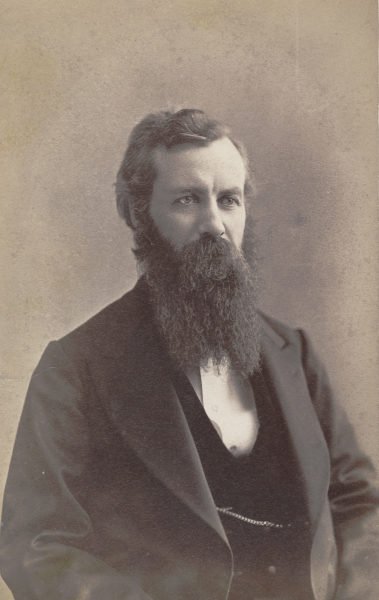
By Vanessa St.Oegger-Menn, Pan Am 103 Archivist and Assistant University Archivist
University Archives and Special Collections Research Center staff have been working on several projects throughout this academic year to commemorate the University’s sesquicentennial. Among these are exhibitions of various sizes, both onsite and digital, including 150 Years of Tradition at Syracuse University, curated by University Archivist Meg Mason, and Let the Reader Emerge! Milestones of the Syracuse University Libraries, curated by Curator for Rare Books and Manuscripts Sebastian Modrow.
We’ve recently added another digital exhibition to our list: A Legacy of Leadership: The Chancellors and Presidents of Syracuse University. An on-site version of this exhibition has been on display on the first floor of Bird Library since September 2019. As the curator of this exhibition, I’m very pleased we can now offer visitors the opportunity to view it online while current circumstances with the COVID-19 health emergency are keeping us all away from campus for the time being. Below are a few highlights and personal favorites from the exhibition.
CHANCELLOR ALEXANDER WINCHELL
January 1873 - June 1874
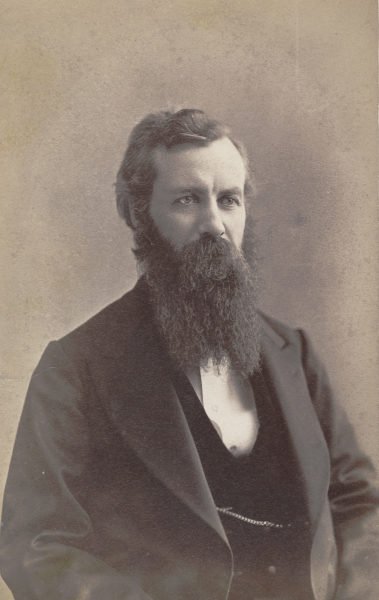
Portrait of Alexander Winchell, circa 1875. Syracuse University Portrait Collection, University Archives. Photograph by W.V. Ranger.
Although Syracuse University marks 24 March 1870 as its official founding date, our first chancellor wasn’t inaugurated until 13 February 1873. Unlike many of his successors, Alexander Winchell was not a member of the clergy of the Methodist Church – the religious denomination that founded Syracuse University. During his tenure, Winchell oversaw the establishment of the College of Medicine and the College of Fine Arts, as well as the completion of the Hall of Languages – the first university building on “The Hill.”
CHANCELLOR CHARLES SIMS
April 1881 - October 1893
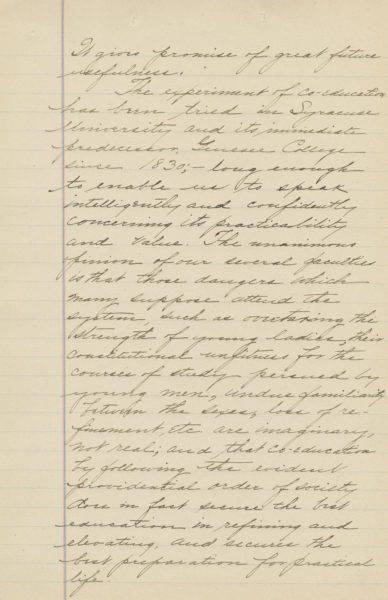
Excerpt concerning the benefits of co-education from Chancellor Sims’ annual report to the Board of Trustees, 24 June 1884. Chancellor Charles N. Sims Collection, University Archives.
I’m proud to work at a university that has been co-educational since its founding and that has championed the contributions of women students and faculty from such an early date. That’s one of the reasons why this excerpt from Chancellor Charles Sims’ 1884 annual report to the Board of Trustees is one of my favorite items in this exhibition. Not only were women like Sarah Loguen breaking barriers at SU in the 19th century, the University recognized the importance of their accomplishments in contributing to a more robust education for all students. “[T]hose dangers which many suppose to attend the system…are imaginary, not real,” Chancellor Sims stated in his address. “[C]o-education…does in fact secure the best education in refining and elevating, and secures the best preparation for practical life.”
CHANCELLOR JAMES ROSCOE DAY
April 1894 - June 1922
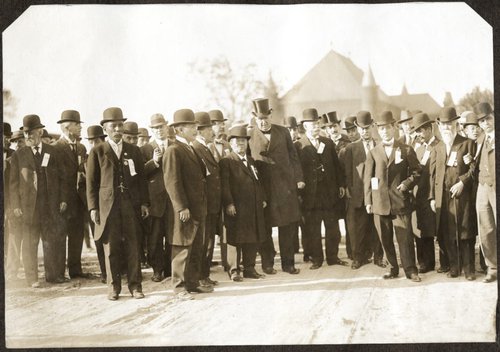
Photograph of Chancellor Day with the Japanese Commission, 9 October 1909. J. Herman Wharton Papers, University Archives.
The University underwent one of its first periods of rapid growth and expansion under Chancellor James Roscoe Day, including an increase in enrollment from roughly 800 to over 6,000 students. With the establishment of 13 new programs and schools, Syracuse University was well and truly on the map as an institution with an international reputation. In 1909, SU even drew the attention of the Japanese Commission who toured campus accompanied by Chancellor Day and the University’s deans. One interesting piece of information I found while researching this visit was that several of SU’s Japanese students were recruited to serve as interpreters. Our University has a long history of welcoming students from all over the world, and it was a pleasure to see several of our early international students acknowledged as key participants in this piece of university history.
CHANCELLOR JOHN E. CORBALLY JR.
September 1969 - March 1971
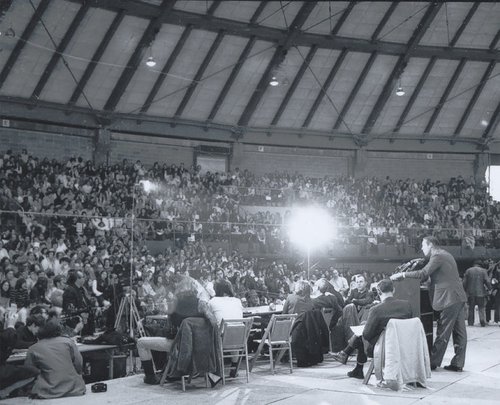
Photograph of Chancellor Corbally addressing the Assembly on Governance town hall meeting, 26 February 1970. Syracuse University Photograph Collection, University Archives
Although John E. Corbally Jr’s tenure as Chancellor and President was among the shortest in SU’s history, it was arguably one of the most fraught. Both the 1970 Student Strike and the Syracuse 8 football boycott occurred during the time Corbally was in office. The University faced the same questions and conflicts confronting American society and higher education during the period of civil rights and anti-Vietnam War activity of the late 1960s into the 1970s. Despite the turbulence of the times, Corbally appears to have been generally remembered for having managed this volatile period on campus well. Though there was much speculation about the reason for his departure in March 1971, Corbally stated he simply couldn’t pass up the opportunity to become president of the University of Illinois and that he left SU with no animosity.
CHANCELLOR MELVIN EGGERS
June 1971 - August 1991
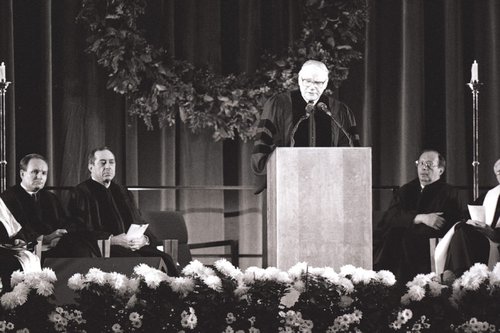
Photograph of Chancellor Eggers at the memorial service for the 35 Syracuse University study abroad students killed in the bombing of Pan Am Flight 103, 18 January 1989. Syracuse University Photo & Imaging Collection, University Archives.
As the archivist for the Pan Am Flight 103/Lockerbie Air Disaster Archives, I spend a great deal of time researching and teaching about the ways in which Chancellor Melvin Eggers and his administration responded to the loss of 35 Syracuse study abroad students as a result of that 1988 terrorist bombing. One of the personal benefits of curating this exhibition was having the opportunity to learn more about Eggers’ career at SU prior to the tragedy, which occurred relatively close to the end of his tenure. All told, Eggers spent over 40 years in service to SU. Among his many contributions during that time, we also have Chancellor Eggers to thank for the Carrier Dome and Schine Student Center – two areas on campus where so many student memories are made.
You can learn more about these items, as well as the other administrations not highlighted in this blog post, by visiting the Legacy of Leadership digital exhibition online. We hope this digital trip through part of Syracuse University’s history can provide an interesting and informative distraction from current events.
The Syracuse University Photograph Collection (Syracuse University Photograph Collection, University Archives, Special Collections Research Center, Syracuse University Libraries), Syracuse University Photo & Imaging Collection (Syracuse University Photo & Imaging Collection, University Archives, Special Collections Research Center, Syracuse University Libraries), Syracuse University Portrait Collection (Syracuse University Portrait Collection, University Archives, Special Collections Research Center, Syracuse University Libraries), Chancellor Charles N. Sims Collection (Chancellor Charles N. Sims Collection, University Archives, Special Collections Research Center, Syracuse University Libraries), and J. Herman Wharton Papers (J. Herman Wharton Papers, University Archives, Special Collections Research Center, Syracuse University Libraries) are part of our University Archives collections.
